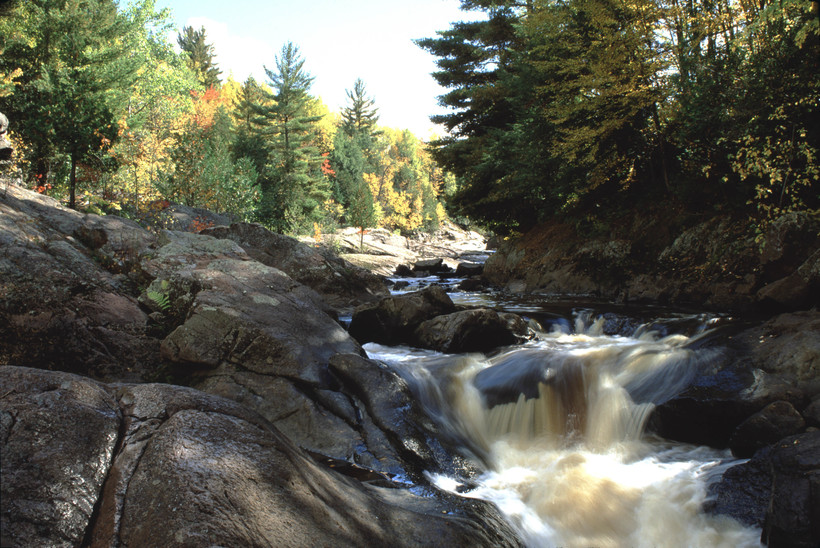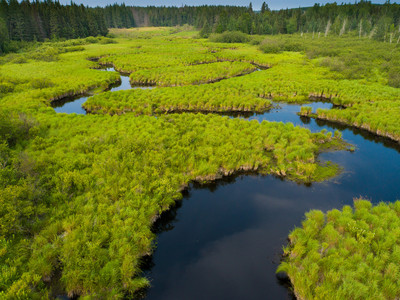State Funding Has Plummeted For Parks, Public Lands, DNR
DNR funding down 41% in 25 years, spending on state parks lowest in U.S., study finds.
When COVID-19 brought lockdowns and gathering restrictions, people flocked to Wisconsin’s outdoors to escape crowds and catch a break from being confined to their homes. But while users crowded parks and trails, the state’s financial support has been on a long decline.
Outdoor recreation contributed $7.8 billion to Wisconsin’s gross domestic product in 2020. The following year, that grew 14 percent to $8.7 billion. Jason Stein, research director for the Wisconsin Policy Forum, said that underscores the public’s strong interest and participation in Wisconsin’s outdoor recreation economy, conservation and public lands.
The state’s outdoor recreation economy is just one example of how the state relies on and benefits from its abundant natural resources, supporting more than 89,000 jobs. Wisconsin’s timber industry ranks second in the nation for employment with around 61,000 workers and generates around $6.9 billion in value to the state’s economy. Hunting and fishing license sales grossed $70 million in 2019, ranking the fourth-highest nationally.
However, a new report from the Wisconsin Policy Forum shows a striking decline in state tax-generated financial support for conservation, public lands and the environment. The report was funded by various organizations that include wildlife, conservation and real estate industry groups. Despite that support, Stein said the research group insists on independence and impartiality when producing its findings.
State tax funding for DNR sees steep declines in last 25 years
Wisconsin has witnessed a dramatic decline in general purpose revenue or state tax funding for the Wisconsin Department of Natural Resources. In the mid-nineties, the agency received $334 million in funding under the 1995-1997 state budget. Under the current budget, the Wisconsin Policy Forum states that revenue declined to $197.5 million.
“It fell almost 41 percent without adjusting for inflation,” Stein said.
The report points to shifting state tax funding for Medicaid, K-12 schools, state prisons and tax cuts as a key reason for the decline in general purpose revenue allocated to the DNR. The forum states the funding drop followed difficult post-recession budgets.
Fred Clark, executive director of Wisconsin’s Green Fire, said there’s a need for increased regulation of large farms known as CAFOs and more staff to work with property owners on shoreline zoning and lakeshore flooding.
“The long-term ramp down of investment in especially GPR revenue toward the Department of Natural Resources is just preventing that agency from effectively addressing some of our greatest environmental challenges,” Clark said.
Tim Gary, the DNR’s budget and policy analyst, didn’t disagree with the report’s calculations. He noted the agency’s staffing and funding levels have fluctuated over time. He said comparisons in funding or staffing may not account for work that’s been contracted out or staff that were shifted to the Department of Tourism when the agency was created in the mid-90s.

Red Granite Falls is one of the waterfalls at Copper Falls State Park northeast of Mellen, Wis. in Ashland County. Photo courtesy of the Wisconsin Department of Natural Resources
“In 1996 and in 2017, the department realigned its operational structure and staffing,” Gary said. “We’ve shuffled around bureaus, and we have come up with ways to continue to provide services to the public using the existing resources that we have today.”
Data from the DNR shows general purpose revenue for state parks operations once made up around 40 percent of the budget four decades ago. Gary noted the shift away from state tax funding for parks began in the mid-90s and culminated in 2015. The Legislative Fiscal Bureau notes the budget eliminated general purpose revenue completely for parks operations under the 2015-2017 budget. To offset the loss of funding, the budget raised fees for parks admission, camping and trail use.
State Senator Rob Cowles, R- Green Bay, said he voted against the 2015-2017 budget in part because it removed general purpose revenue for the state park system.
Cowles said he’s worked on several bills that devoted more than $15 million for upgrading water infrastructure at state parks, adding the current budget funded 16 capital projects that were requested by the DNR.
The report points to survey data from the National Association of State Parks Directors, saying it shows the state spent the lowest amount on parks nationwide at about $1 per visit in 2017. That compares to the national average of $3 per visit.
On average, parks admission fees were updated once every five years until 2005, according to the DNR. Gary, the DNR’s budget analyst, said there was a 10-year gap until they were adjusted, and it’s been 8 years since they were last revisited.
He said there’s money available in the state’s forestry and parks accounts, but a change in state statutes is required to allow the DNR to spend that additional revenue. Gov. Tony Evers‘ budget would increase the agency’s spending authority to allow funding of maintenance and development projects.
Funding is declining for fish and wildlife, land acquisition
Separate accounts established to fund fish and wildlife programs and the state parks system make up a bit more than two-thirds of the overall revenues within the state’s conservation fund. According to the state’s fiscal bureau, around 69 percent of the fund’s $295.7 million came from the DNR’s forestry and fish and wildlife accounts. Funding for fish and wildlife fell to $70.7 million last year, down from $79.5 million in 2021.
Meanwhile, the state’s land acquisition program has seen a steady erosion in funding as lawmakers have expressed concerns about preserving public lands and taking them off the tax rolls. Since 1990, the Knowles-Nelson Stewardship program has helped the DNR purchase more than 723,000 acres of land using nearly $561 million in stewardship funds. Overall, the state has acquired more than 879,000 acres through federal and state sources, as well as donations.
Spending under the program dropped to its lowest level in at least two decades to $14.1 million last year, according to the report. That’s down 83 percent from $84 million in 2007 before adjusting for inflation.
Charles Carlin, director of strategic initiatives for Gathering Waters, said the report demonstrates a lack of investment by policymakers.

The Conservation Fund purchased 70,000 acres of the Pelican River Forest in northern Wisconsin from the investment firm The Forestland Group. The purchase aims to set aside land for recreational use and logging for years to come. Jay Brittain/The Conservation Fund
“The report just demonstrates that there’s this enormous gap between how Wisconsin residents value the outdoors, both for the economy and for taking care of us for health and for recreation, and how the state actually values those same resources through the investments put into it or not in this case,” Carlin said.
Carlin said legislative obstruction has made it more difficult to preserve public lands. He cited lawmakers’ recent objection to using Stewardship funds for what would be the largest land conservation effort in state history with the Pelican River Forest project. While Sen. Mary Felzkowski, R-Irma, made her concerns public, other lawmakers on the state’s budget-writing committee have been able to raise anonymous objections. Evers’ budget seeks to change that.
The Stewardship program is currently funded through 2026 at roughly $33 million, including $8 million in cash and $25 million through bonding. GOP lawmakers, including former state Senator and now Congressman Tom Tiffany, have argued the cost of buying and maintaining public lands has created too much debt.
Debt payments from Stewardship borrowing are beginning to drop, but the report notes they remain above levels in the 1990s and early 2000s.
Report outlines potential conservation funding options
The report suggests a slate of options to raise funds for conservation. They include increasing hunting and fishing fees to match inflation, which could boost funding by $24 million.
The Wisconsin Policy Forum also said the state could explore redirecting revenues from real estate transfer fees toward conservation of public lands. The state could also examine pursuing new sales tax revenues for parks. The report notes Minnesota has generated $2.9 billion for clean water, parks and the outdoors through a .375 percent sales tax.
In Colorado, the state has created an income tax credit for land that has helped conserve more than 434,000 acres for around $181 million.
Stein said Wisconsin could also explore donated easements and expanding local collaboration to fund parks, forestry and conservation services.
Listen to the WPR report here.
Report: State tax funding for conservation and parks has steadily eroded over decades was originally published by Wisconsin Public Radio.
If you think stories like this are important, become a member of Urban Milwaukee and help support real, independent journalism. Plus you get some cool added benefits.























It’s very sad that all the things that have made Wisconsin great – our State parks, lakes and woodlands, affordable University education, quality public schools, clean air and water, good roads, clean communities, responsible citizens, care for our elderly and affordable health care have all deteriorated under the malevolent oversight of the politicians currently in power..
As a taxpayer, I’d rather have seen the money that the Assembly gave to Gableman go to our state parks. At least we would have seen some benefit.
And, of course, those “politicians currently in power” see little sense in investing precious monetary resource into land they would happily subdivide and sell off. And they are called “conservatives?”
Republican US Rep. Tom Tiffany is complaining about $33 million for land stewardship purchases adding to the state’s debt. Then he votes to spend $778,000,000,000.00 billion on defense spending?
No. 2 in world defense spending is China at $252 billion. It seems like Tom doesn’t mind blowing our money on the military but he goes nuts over purchasing land for the people of Wisconsin.
I have news for Mincoqua Tom. I invite him to join me on my weekly drive on Highway 70. From there I can see a number of lakes that are so full of algae that the county is pumping air into them. That cannot last long or will be very expensive as we expand it to more dying lakes. Let us protect what is important to us, and leave the crocodile tears of deficit spending to Tom.